| Pages:
1
2 |
Lion850
National Hazard
   
Posts: 514
Registered: 7-10-2019
Location: Australia
Member Is Offline
Mood: Great
|
|
Report on making metal sorbates
60g potassium sorbate was dissolved in 120g water. The salt dissolved quite easy once stirred, heating was on but it gave a clear solution long before
it was hot. The purpose of this solution (total weight now 180g) was to use 30g portions, each containing 10g potassium sorbate, and perform double
displacement reactions with metal salts and see what happens.
Copper:
- 8.3g CuSO4.5H2O was dissolved in 30g hot water.
- Add 30g of the potassium sorbate solution while stirring.
- A thick blue emulation formed that would not stir. 150ml water was added and the solution then stirred for 5 minutes. This was the result.
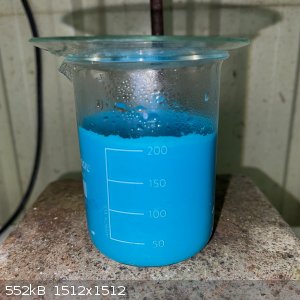
- Gravity filter. The filtration went quite fast, which was good. The filtrate was clear and there was a blue remainder.
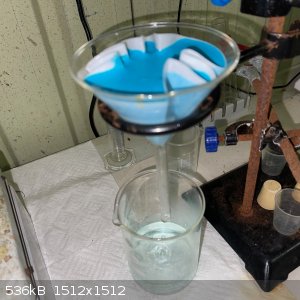
- The remainder was washed in the funnel and then left out on the bench overnight to see how it dried. But the next morning the weight was almost the
same.
- It was then dried on a steam bath. Some 5 hours drying was needed before the weight loss reduced to near zero. The result was this light blue
powder; there was almost no colour change between the wet and dry product.
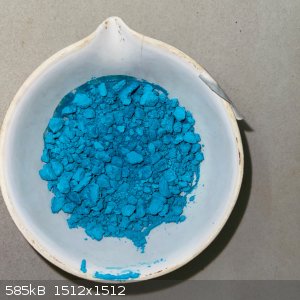
- 9.5g of product was recovered. It seems very light, as it filled up my little vial completely: this is unusual for something with a weight of under
10g.
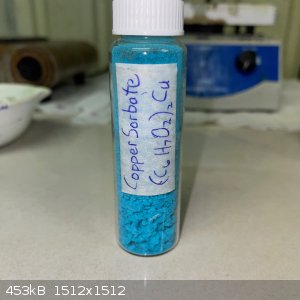
Afterwards I poured concentrated HCl into the evaporation dish that still contained a bit of product expecting to get a green copper chloride
solution. But after an hour it seemed that very little of the copper sorbate reacted with the acid; the crystals did turn a bit green in colour but
not the acid.
Cobalt will probably be next.
|
|
|
njl
National Hazard
   
Posts: 609
Registered: 26-11-2019
Location: under the sycamore tree
Member Is Offline
Mood: ambivalent
|
|
The low density is an interesting effect. Have you tested the solubility? Maybe a crystallization with increase it. If not... cool!
Reflux condenser?? I barely know her!
|
|
|
woelen
Super Administrator
        
Posts: 7976
Registered: 20-8-2005
Location: Netherlands
Member Is Offline
Mood: interested
|
|
Interesting result. The low density most likely is due to trapped air. I think that you obtained a thick suspension, containing a lot of water, which
after filtering and rinsing still had a lot of water in it. After drying, the space, taken by this water, is filled up with air. The structure of the
solid particles, how they stick together and build a 3D structure, apparently is quite stable, even when dried. This explains why there hardly is any
change of color (structure and particle arrangement remain the same after drying) and it also can explain the low density.
|
|
|
njl
National Hazard
   
Posts: 609
Registered: 26-11-2019
Location: under the sycamore tree
Member Is Offline
Mood: ambivalent
|
|
Could the density then be increased by finely powdering the product?
Reflux condenser?? I barely know her!
|
|
|
Lion850
National Hazard
   
Posts: 514
Registered: 7-10-2019
Location: Australia
Member Is Offline
Mood: Great
|
|
Thanks for the comments gents. For sure fine powdering will reduce the volume occupied in the vial, maybe by 50%! I like the look of the chunks thus I
did not powder it.
Njl I am quite sure solubility in water is very low - when washed in the funnel with the water the run-through water was clear.
|
|
|
Lion850
National Hazard
   
Posts: 514
Registered: 7-10-2019
Location: Australia
Member Is Offline
Mood: Great
|
|
Cobalt:
- 9.4g cobalt sulphate CoSO4.7H2O was dissolved in 30ml water giving a dark red solution
- Add 30g solution containing 10g potassium sorbate
- A light purple suspension formed.
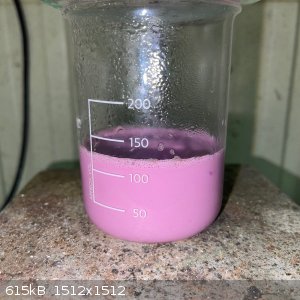
- Gravity filter and rinse with water in funnel. The filtrate and wash water run through was red meaning either the cobalt sulphate was in excess or
the product is soluble.
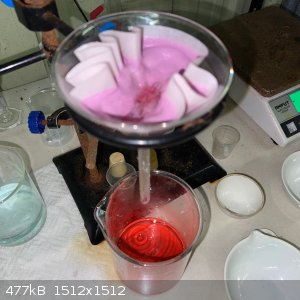
- The remainder looked more purple once it dried in the evaporating dish overnight.
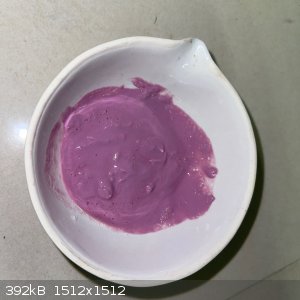
- During drying on the steam bath a darker crust formed on top with more or less the same lighter purple underneath.
- Only 3.5g was recovered while much closer to 10g was expected (like the copper). Thus, I am not sure what actually formed.
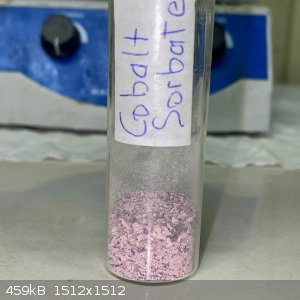
Similarly to the copper salt described above, this cobalt salt is also not reactive with concentrated HCl. HCl was poured into the evaporating dish
once the product was scraped out, but the remaining smears of product did not seem to have dissolved in the acid, not even 24 hours later.
|
|
|
Lion850
National Hazard
   
Posts: 514
Registered: 7-10-2019
Location: Australia
Member Is Offline
Mood: Great
|
|
Chromium:
- 8.7g chromium nitrate Cr(NO3)3.9H2O was dissolved in 30g water giving a black solution.
- 30g of the potassium sorbate solution, thus 10g of potassium sorbate, was added and stirred
- The solution immediately turned grey but with a hint of green or even blue depending on the light and who was looking!
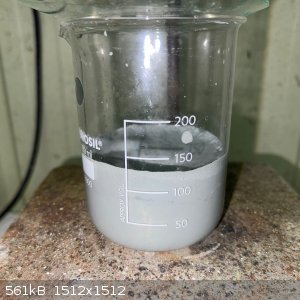
- The solution was gravity filtered. Like the previous 2, filtering these compounds is easy thus quick. The filtrate was still a bit grey, and it was
observed that this product is so fine some goes through the filter paper.
- The product was washed in the funnel with water, scraped into an evaporating dish and this is what is looked like after standing on the bench 48
hours.
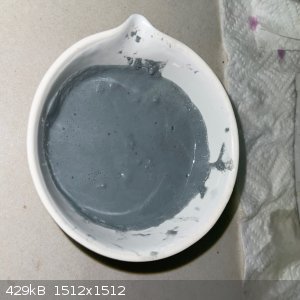
- It was then placed on the steam bath. It takes more than 2 hours for the beaker I boil the water in to run out so I usually set an alarm for 2 hours
and then go back to the shed. But when I walked past the shed an hour later I smelled a sweet smell, saw smoke, and on closer inspection observed that
the product was decomposing with pops and small flames around the edge of the evaporating dish (where the temp must have been higher than the centre).
I switched off the hot plate and squired in water.
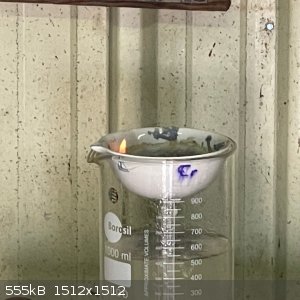
This is the aftermath.
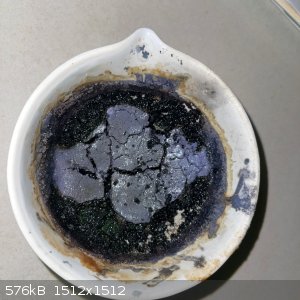
So was it purely the product that formed that had a low decomposition temperature of was there some nitrate present from the reaction that then
reacted with the product due to the steam bath heat? I suppose one way to find out is to repeat the experiment but start with chromium sulphate
instead of chromium nitrate.
|
|
|
njl
National Hazard
   
Posts: 609
Registered: 26-11-2019
Location: under the sycamore tree
Member Is Offline
Mood: ambivalent
|
|
| Quote: |
The filtrate and wash water run through was red meaning either the cobalt sulphate was in excess or the product is soluble.
|
| Quote: |
9.4g cobalt sulphate CoSO4.7H2O
|
Probably the former if this paper holds up. According to this paper the heptahydrate is unstable at room temperature below 70 percent humidity. If you did your math
based on the heptahydrate but instead used the hexahydrate you would have excess CoSO4.
Reflux condenser?? I barely know her!
|
|
|
Lion850
National Hazard
   
Posts: 514
Registered: 7-10-2019
Location: Australia
Member Is Offline
Mood: Great
|
|
NJL that is quite possible. My cobalt sulphate is very old and light coloured. Still will explain the red filtrate but not why the yield was so low.
Any thoughts regarding what happened to the chromium product that decomposed on the steam bath as mentioned above?
|
|
|
vano
National Hazard
   
Posts: 661
Registered: 22-3-2019
Location: Georgia
Member Is Offline
|
|
Nice work lion850
|
|
|
draculic acid69
International Hazard
    
Posts: 1371
Registered: 2-8-2018
Member Is Offline
|
|
Quote: Originally posted by Lion850  | 60g potassium sorbate was dissolved in 120g water. The salt dissolved quite easy once stirred, heating was on but it gave a clear solution long before
it was hot. The purpose of this solution (total weight now 180g) was to use 30g portions, each containing 10g potassium sorbate, and perform double
displacement reactions with metal salts and see what happens.
Copper:
- 8.3g CuSO4.5H2O was dissolved in 30g hot water.
- Add 30g of the potassium sorbate solution while stirring.
- A thick blue emulation formed that would not stir. 150ml water was added and the solution then stirred for 5 minutes. This was the result.
- Gravity filter. The filtration went quite fast, which was good. The filtrate was clear and there was a blue remainder.
- The remainder was washed in the funnel and then left out on the bench overnight to see how it dried. But the next morning the weight was almost the
same.
- It was then dried on a steam bath. Some 5 hours drying was needed before the weight loss reduced to near zero. The result was this light blue
powder; there was almost no colour change between the wet and dry product.
- 9.5g of product was recovered. It seems very light, as it filled up my little vial completely: this is unusual for something with a weight of under
10g.
Afterwards I poured concentrated HCl into the evaporation dish that still contained a bit of product expecting to get a green copper chloride
solution. But after an hour it seemed that very little of the copper sorbate reacted with the acid; the crystals did turn a bit green in colour but
not the acid.
Cobalt will probably be next.
|
You have synthesized smurf.very nice
|
|
|
mayko
International Hazard
    
Posts: 1218
Registered: 17-1-2013
Location: Carrboro, NC
Member Is Offline
Mood: anomalous (Euclid class)
|
|
I had some potassium sorbate on hand so I decided to try this. The manganese salt came out a butter yellow, not what I was expecting at all!
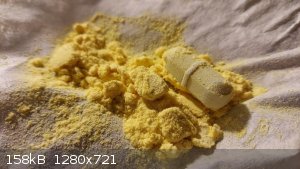
the potassium sorbate was in the form of small beads or prills; when they were poured into water to dissolve, they zipped around the beaker almost
like tadpoles. It was very odd to see, and I'm having trouble imagining a mechanism
[Edited on 16-5-2021 by mayko]
al-khemie is not a terrorist organization
"Chemicals, chemicals... I need chemicals!" - George Hayduke
"Wubbalubba dub-dub!" - Rick Sanchez
|
|
|
Lion850
National Hazard
   
Posts: 514
Registered: 7-10-2019
Location: Australia
Member Is Offline
Mood: Great
|
|
Hi Mayko a yellow salt with manganese is indeed interesting, I will try and see if I get the same result. I have manganese sulphate and nitrate to
start from. Which manganese salt did you use?
My potassium sorbate is a coarse powder, I did not see any unusual when I dissolved it.
|
|
|
ChemTalk
Hazard to Self
 
Posts: 65
Registered: 13-12-2018
Location: United States
Member Is Offline
Mood: colloidal
|
|
Very interesting Lion850, thanks for sharing these compounds
|
|
|
Lion850
National Hazard
   
Posts: 514
Registered: 7-10-2019
Location: Australia
Member Is Offline
Mood: Great
|
|
Quote: Originally posted by mayko  | I had some potassium sorbate on hand so I decided to try this. The manganese salt came out a butter yellow, not what I was expecting at all!
the potassium sorbate was in the form of small beads or prills; when they were poured into water to dissolve, they zipped around the beaker almost
like tadpoles. It was very odd to see, and I'm having trouble imagining a mechanism
[Edited on 16-5-2021 by mayko] |
I made manganese sorbate but it turned out a cream color - with a very slight hint of yellow to the eye but this is not picked up on photos.
- 5.8g MnSO4.H2O was dissolved in 50ml water. This gave a very pale pink solution.
- Add a solution containing 10g potassium sorbate under stirring, all reagents at room temp thus around 25C.
- A creamy suspension immediately formed.
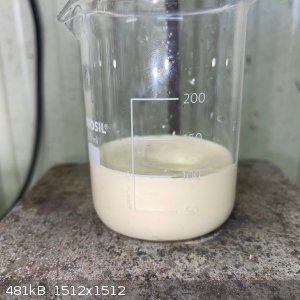
- Stir for another 10 minutes.
- Gravity filter. Wash in funnel. The filtrate was clean and the remainder as shown here:
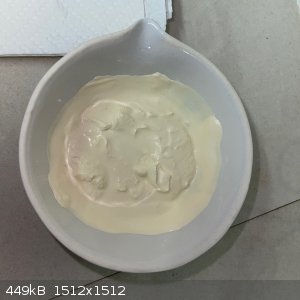
- Leave on bench for 24 hours, but the weight loss was minimal. Dry on steam bath until weight loss rate was near zero.
- Final product was 8.7g of light, fluffy soft powder. Drying did not change the color, still like cream with a very slight tinge of yellow, and just
a hint of pink at some angles.
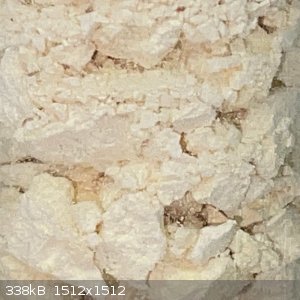
Mayko I don't know why the color of the products we got are so different. Which manganese compound did you use and what was the weights of the
manganese compound and the potassium sorbate?
I could not find a description of manganese sorbate online.
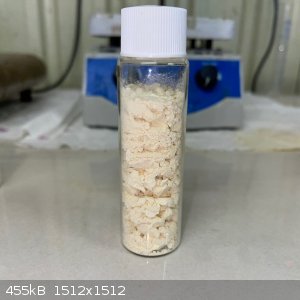
|
|
|
Lion850
National Hazard
   
Posts: 514
Registered: 7-10-2019
Location: Australia
Member Is Offline
Mood: Great
|
|
Iron sorbate:
Iron (ii) sulphate monohydrate was dissolved in water. It dissolved with difficulty at room temperature but much easier when the water is near
boiling. However by the time it was all dissolved the solution was not green-ish but as shown below; maybe I ended up with iron (iii) after the
boiling and stirring?
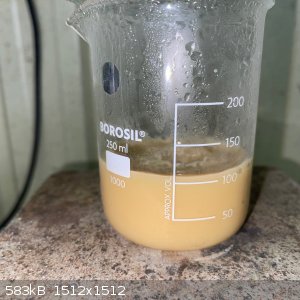
A solution of potassium sorbate was added to the still very hot iron sulphate solution. A honey coloured suspension formed over a few minutes:
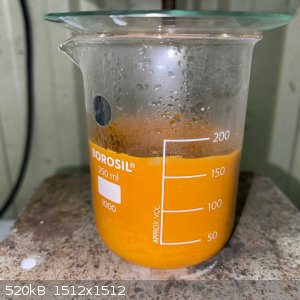
The solution was filtered. The filtrate was still coloured; maybe the iron sulphate was in excess. The remainder was rinsed in the funnel a few times
and then dried on a steam bath. This was the appearance half way through the drying:
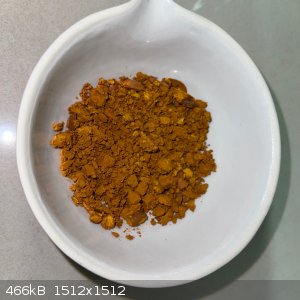
And the final bottled product.
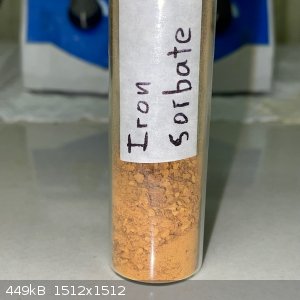
An interesting side observation was that the stir bar was coated with a layer of similar colour. It would not rub off. I then stirred it in some
concentrated room temp HCl, but the layer removed. I then heated the HCl while stirring, and once near boiling it dissolved the layer on the stir bar.
|
|
|
Lion850
National Hazard
   
Posts: 514
Registered: 7-10-2019
Location: Australia
Member Is Offline
Mood: Great
|
|
Nickel sorbate:
The only nickel salt I have lots off is nickel nitrate so that was my nickel source. Below shows the solution of nickel nitrate and potassium sorbate
prior to mixing.
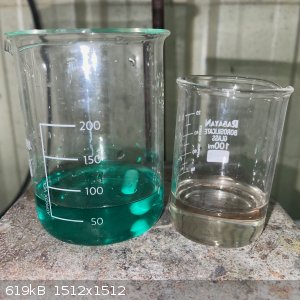
Once mixed, a pale green suspension formed. After stirring a few minutes the solution was filtered; the remainder was still a bit green so the nickel
nitrate was probably in slight excess.
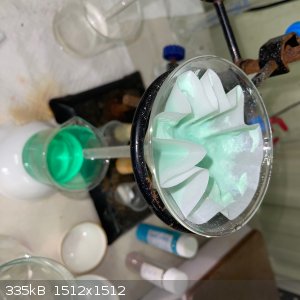
In the photo below the evaporating dish with the green substance shows the wet nickel sorbate remainder.
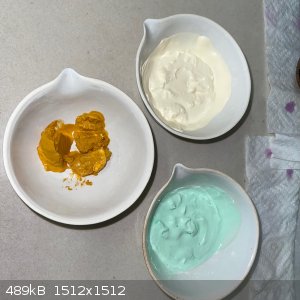
After seeing the chromium sorbate decompose on the steam bath I tried to dry the nickel sorbate in the sun under a steel dish, as both chromium and
nickel were derived from nitrates. But it did not want to dry in the sun so onto the steam bath it went.
After 2 runs on the steam bath I had a near dry pale green powder (sadly I did not take a photo). I started the 3rd run and when I came back an hour
later it had decomposed!
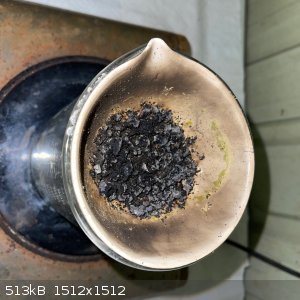
After scratching out most of the remains into the disposal bin I poured concentrated HCl into the dish to see if it would remove the rest. I was a bit
surprised to see some bubbling. There was no smell, but holding a lit match to the bubbles they burned with pops just like hydrogen does. I thought
hydrogen with the HCl could only be explained if there was elemental nickel present in the remains, which I did not expect. Is elemental nickel one of
the products when nickel sorbate decomposes?
|
|
|
woelen
Super Administrator
        
Posts: 7976
Registered: 20-8-2005
Location: Netherlands
Member Is Offline
Mood: interested
|
|
It must almost certainly be nickel metal, or some weird low oxidation state compound, but I never heard of that. This is a most interesting
observation and definitely needs more investigation!
Some metal salts can decompose to the metal and other stuff (e.g. silver oxide, mercury iodide, even silver nitrate on stronger heating), but with
nickel I would not expect that. Iron can decompose to very reactive iron(II) oxide, but for nickel I do not know any reactive nickel(II) species and
nickel(I) species I do not expect from sorbate.
Do you know what temperature there was when it decomposed?
I also would be careful with the waste. If this stuff can produce hydrogen with dilute acids, then it might be a very reactive and flammable compound.
Having it in a waste bin, which can contain moisture, could lead to exothermic reactions (the above mentioned iron(II) oxide is an example of such
very reactive stuff, which even can ignite under certain conditions).
|
|
|
unionised
International Hazard
    
Posts: 5102
Registered: 1-11-2003
Location: UK
Member Is Offline
Mood: No Mood
|
|
Lots of lovely colours- and nice to see people doing actual chemistry. :-)
I wonder if any of you has access to europium?
Some europium chelates (e.g. the dibenzoylmethane compound) are quite strongly fluorescent because the chelating agent absorbs the UV efficiently and
transfers energy to the Eu+++which emits light.
I wonder if the sorbate ion (which has a UV absorption more or less coinciding with the Hg emission line at 254 nm) would do the same thing.
If it works you should be able to see the bright red Eu emission even if you only make it on a mg scale
|
|
|
DraconicAcid
International Hazard
    
Posts: 4278
Registered: 1-2-2013
Location: The tiniest college campus ever....
Member Is Offline
Mood: Semi-victorious.
|
|
Quote: Originally posted by woelen  | It must almost certainly be nickel metal, or some weird low oxidation state compound, but I never heard of that. This is a most interesting
observation and definitely needs more investigation!
Some metal salts can decompose to the metal and other stuff (e.g. silver oxide, mercury iodide, even silver nitrate on stronger heating), but with
nickel I would not expect that. Iron can decompose to very reactive iron(II) oxide, but for nickel I do not know any reactive nickel(II) species and
nickel(I) species I do not expect from sorbate. |
I wouldn't expect nickel(I) compounds to form. You might get nickel powder from Ni(O2CR)2 --> 2 Ni + RR + 2 CO2 (or similar reaction).
Because sorbate is a diene, you might also get organometallic Ni-olefin complex. But that would be very air-sensitive (more so than nickel powder).
Please remember: "Filtrate" is not a verb.
Write up your lab reports the way your instructor wants them, not the way your ex-instructor wants them.
|
|
|
mayko
International Hazard
    
Posts: 1218
Registered: 17-1-2013
Location: Carrboro, NC
Member Is Offline
Mood: anomalous (Euclid class)
|
|
The manganese compound you got looks more like what I expected, not sure what's going on. My first batch was 4.49 g manganese sulfate (presumably
monohydrate, 0.027mmol) and 3.45 potassium sorbate (0.023 mmol). I must have messed up my stoichiometry, so I went back and did a second batch: 1.70g
manganese sulfate ( 0.010 mmol) and 3.4 g potassium sorbate (0.023 mmol). This came out slightly lighter, but still distinctly yellow. I also tried
manganese chloride (tetrahydrate, 1.95 g, 0.010 mmol) and potassium sorbate (3.24g, 0.022 mmol), but this was basically the same color.
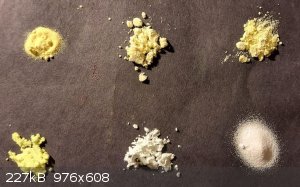
Top row, L-R: manganese sulfate with 1:1 proportions, manganese sulfate with 1:2 proportions, manganese chloride with 1:2 proportions,
Bottom row, L-R: sulfur, corn starch, manganese sulfate
My first thought was iron contamination, since the ferric salt is a bright, school bus yellow. But I think that can be ruled out because:
* Neither manganese salt nor the potassium sorbate tests positive by thiocyanate
* the manganese chloride was specifically purified of iron, and
* the ferric salt is actually soluble in alcohol, forming an intensely colored solution. steeping the yellow salt in alcohol neither discolors the
liquid nor bleaches the solid
So, I'm not entirely sure what's going on. The only thing I can think is that it's not an intrinsic property of the substance but caused by different
particle size distributions under different reaction conditions?
Like I mentioned, the ferric salt is very bright orange-yellow, and unexpectedly dissolves in alcohol. I discovered this when I tried to rinse the
precipitate with some IPA after filtering  I'm trying to coax a recrystallization
out of it though I'm trying to coax a recrystallization
out of it though
I don't think the ferrous salt is very air-stable at all. Even stoppered at room temperature, the murky grey-green mixture developed an orange crust
at the liquid/air interface overnight.
al-khemie is not a terrorist organization
"Chemicals, chemicals... I need chemicals!" - George Hayduke
"Wubbalubba dub-dub!" - Rick Sanchez
|
|
|
Lion850
National Hazard
   
Posts: 514
Registered: 7-10-2019
Location: Australia
Member Is Offline
Mood: Great
|
|
Woelen - All I know is that the decomposition mush have started at below 100C as it was on a very slow boiling steam bath. Which temperature was
reached once the reaction got going I don't know. When I returned to the shed after being away an hour there was no smoke or smell at all, just the
remains. Where my wife sits and works she can see the shed door and she probably would have noticed if there was a reasonable amount of smoke, so
either it decomposed without any smoke or very little smoke. What also intrigues me is that the 2 sorbates that decomposed on the steam bath, chromium
and nickel, were both made starting from the nitrate salts. Is this just coincidence of is the decomposition started because there of the presence of
small quantities either of the original metal nitrates or the formed potassium nitrate? I should try the nickel again but from another nickel salt,
not the nitrate and see what happens. But I will have to make another salt first.
Mayko - thanks for your info. Interesting stuff.
|
|
|
woelen
Super Administrator
        
Posts: 7976
Registered: 20-8-2005
Location: Netherlands
Member Is Offline
Mood: interested
|
|
Interesting observations. I have some sorbic acid. I have nickel sulfate and nickel nitrate. So, I could try both of them in small quantities and see
how the decomposition goes. I'll try to find some time next weekend.
|
|
|
woelen
Super Administrator
        
Posts: 7976
Registered: 20-8-2005
Location: Netherlands
Member Is Offline
Mood: interested
|
|
I did some experiments last weekend. I prepared nickel sorbate from solutions of nickel nitrate and nickel sulfate. I happened to have some potassium
sorbate, bought years ago, but still in good condition.
Experiment 1:
----------------
Prepare a concentrated solution of nickel nitrate and a concentrated solution of potassium sorbate.
Take half of each of the solutions and dilute with 10 times their volume of water and then mix both solutions: No precipitate is formed, the solution
remains clears and green, like a plain aqueous nickel(II) solution.
Take the other halves of the concentrated solutions and mix them: A pale green suspension is formed, just like the one, obtained by Lion850.
Filter the suspension and put the wet paste, obtained in this way, in a petri dish and spread the paste so that it dries more easily. Put the paste in
a warm place (40 C or so) and let it stand for two days.
The remains of the paste, still sticking to the filter, were rinsed from the filter with a little water. While doing so, all of that solid dissolved
in the water and gave a pale green solution.
Experiment 2:
----------------
Do the same as in experiment 1, but now with a concentrated solution of nickel(II) sulfate 6-hydrate. Again, a pale green suspension is obtained,
looking very similar to the one, obtained with the nitrate.
Filter the suspension and put the wet paste, obtained in this way, in a second petri dish and again, spread the paste so that it dries more easily.
Also put this paste in a warm place (40 C or so) and let it stand for two days.
After two days, but petri dishes with pase were perfectly dry and the solid could easily be scraped off the glass. This gives a pale green powder in
both cases. After crunching the powder, one cannot see any difference between the powder, made from nickel nitrate and the powder, made from nickel
sulfate.
An important obervation during these experiments was that quite concentrated solutions are needed in order to make a preciptitate. Apparently
nickel(II) sorbate is quite soluble in water, much more so than e.g. nickel(II) hydroxide. This is not a good thing. Use of the concentrated solutions
means that the precipitate will be quite impure. From such concentrated solutions you will have a lot of coprecipitated nitrate (or sulfate) ions and
potassium ions, which cannot be rinsed away without losing all of your precipitate.
In a final experiment, I took some of both powders and carefully heated this in a test tube.
- The powder, made from nickel nitrate, turns black and then suddenly, a violent reaction started, showing some incandescence and giving a little
smoke, looking very much like thick cigarette smoke, leaving brown stains on the glass. The smell of this smoke was like the smell of partially burned
paper tissue, a little more pungent. It was quite unpleasant. After the decomposition reaction, a black blob remains. I put the black blob in some
dilute H2SO4. This produced a little bubbling, but too little gas was produced to test its flammability. Maybe the bubbles were not even from a
chemical reaction, but simply bubbles, trapped in holes inside the black blob.
- The powder, made from nickel sulfate, also turns black, but this does not show a violent reaction, not even on stronger heating. On stronger
heating, bubbles of gas are produced, which can be ignited and burn with a sooty flame.
These experiments confirm that the product, made from nickel nitrate, indeed decomposes violently, when heated sufficiently strongly. The nitrate ions
act as oxidizer and in that reaction sufficient heat is produced to keep the reaction going, even when the heat source is taken away, and to produce a
little incandescence. The product, made from nickel sulfate, also decomposes on heating, but now there is no exothermic oxidation of the organic
material in the heated product.
This experiment also shows that the product, obtained from the pale green suspension, is very impure. I already have a lot of experience with
suspension-like precipitates or slimy precipitates and these are very hard to obtain in a pure state. If such precipitates are very insoluble (e.g.
nickel(II) hydroxide, basic nickel carbonate, basic copper carbonate), then one can let the precipitate settle, decant most of the supernatant liquid,
add a lot of water, shake, let settle, decant, repeat a few times. This makes a fairly pure product. But with precipitates which are somewhat soluble,
this strategy does not work.
I now have some dried green powder left of both experiments. I'll try dissolving this in a little boiling water and then see what happens on cooling
down. If its solubility is better in hot water than in cold water, then on cooling down I may get actual crystals, instead of some suspension or
flocculent matter. Crystals are more dense, can be easily separated from the liquid and usually are much purer. I'll come back on this later, when I
have done the recrystallization experiment.
|
|
|
Lion850
National Hazard
   
Posts: 514
Registered: 7-10-2019
Location: Australia
Member Is Offline
Mood: Great
|
|
Woelen thanks for the report. Yes my solutions were quite concentrated, and the solubility may also explain why my wash water was still pale green. I
also saw the brown stains you mentioned on my evaporating dish. I don't know what there stains are but the concentrated HCl did not dissolve them and
it has now been sitting more than a week with 70% HNO3 and the stains are still there. I haven't tried simply wiping them off yet.
|
|
|
| Pages:
1
2 |